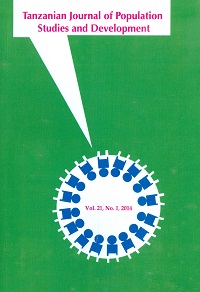Compliance with the National Health Insurance Fund in Tanzania: Could Out-of-Pocket be a Better Option?
Abstract
This study analyzes the National Health Insurance Fund (NHIF) in Tanzania with the objective of determining the level of compliance with this scheme, and the factors that would determine such compliance. Primary data from primary school teachers in Kilimanjaro and Dar es Salaam regions were collected through a questionnaire that required respondents and their households to give the history of their health status, and their valuation of NHIF. The results show that compliance with NHIF is correlated with age, sex, marital status, and location of the residence of the members. Other factors that have been found significant in determining compliance of the members include presence of an old aged dependant, use of public health facility, number of sick household members, occupation status, availability of drugs when using NHIF, and the type of disease episode befalling the household. A majority of members still prefer out-of-pocket compared to NHIF, though the former seems be expensive and not poor friendly. The study proposes a balance between the provision side of health care and the membership to NHIF as the latter has influence on compliance.
References
Abraham, J., W. Vogt, et al. (2002). Household Demand for Employer-Based Health Insurance. NBER Working Paper 9144. Cambridge, National Bureau of Economic Research
Arrow, K. (1963). "Uncertainty and the Welfare Economics of Medical care." American Economic Review 111(5): 941-973.
Besley, T. (1989). "Publicly Provided Disaster Insurance for Health and the Control of Moral Hazard." Journal of Public Economics 39: 141-156.
Bollen, K., D. Guilkey, et al. (1995). "Binary Outcomes and Endogenous Explanatory Variables: Test and Solutions with an Application to the Demand for Contraceptive use in Tunisia." Demography 32: 111-131.
Dong, H., B. Kouyate, et al. (2003). "Gender's Effect on Willingness-to-pay for community based health insurance in Burkina Faso." Health Policy 64(2): 153-162.
Feldstein, P. (1993). Health care Economics. New York, John Wiley and sons.
Friedman, M. and L. J. Savage (1948). "The Utility Analysis of Choices Involving Risk." Journal of Political Economy 56(4): 279-304.
Heckman, J. (1978). "Dummy Endogenous Variables in a Simultaneous Equation System." Econometrica 46: 931-959.
Langa, K., A. Fendrick, et al. (2004). "Out of Pocket Health Care Expenditure among older Americans with Cancer." Value in Health 7(2): 186-193.
Liu, Y. (2002). ""Reforming China's Urban Health Insurance System"." Health Policy 60: 134-150.
Mechanic, D., T. Ettel, et al. (1990). "Choosing among health insurance options: a study of new employees." Inquiry 27(1): 14-23.
Newhouse, J. P. (1978). The Economics of Medical Care. Reading, MA, Addison-Wesley.
NHIF (2004). NHIF Acturial and Statistical Bulletin.
Osei-Akoto, I. (2003). Demand for Voluntary Health Insurance by the Poor in Developing Countries: evidence from rural Ghana. Paper presented at CEA 37th Annual Meeting. Ottawa, Canada, Carleton Unviersity, .
PHRplus (2006). Catalogue of Community Based Health Financing Schemes Tanzania, PHRplus and CHeFA-EA.
Quaye, R. K. (2004). "Paying for Health Services in East Africa: a research note." Social Theory and Health 2(1): 94-105.
Sanhueza, R. and J. Ruiz-Tagle (2002). "Choosing Health Insurance in a Dual Health Care System: The Chilean Case." Journal of Applied Economics V(1): 157-184.
Selden, T. (1993). "Should the Government Provide Catastrophic Insurance." Journal of Public Economics 51: 241-247.
Smith, B. and P. Rawal (1992). "Can the poor afford 'free' health services? A case study of Tanzania." Health Policy and Planning 7(4): 329-341.
URT (1999). The National Health Insurance Fund Act, The United Republic of Tanzania.
Wagstaff, A. (1999). "Equity in the Finance of Health Care: some further international comparisons." Journal of Health Economics 18: 263-290.
WHO (2000). Health Systems: Improving Performance. Geneva, Switzerland, World Health Report-WHO.


